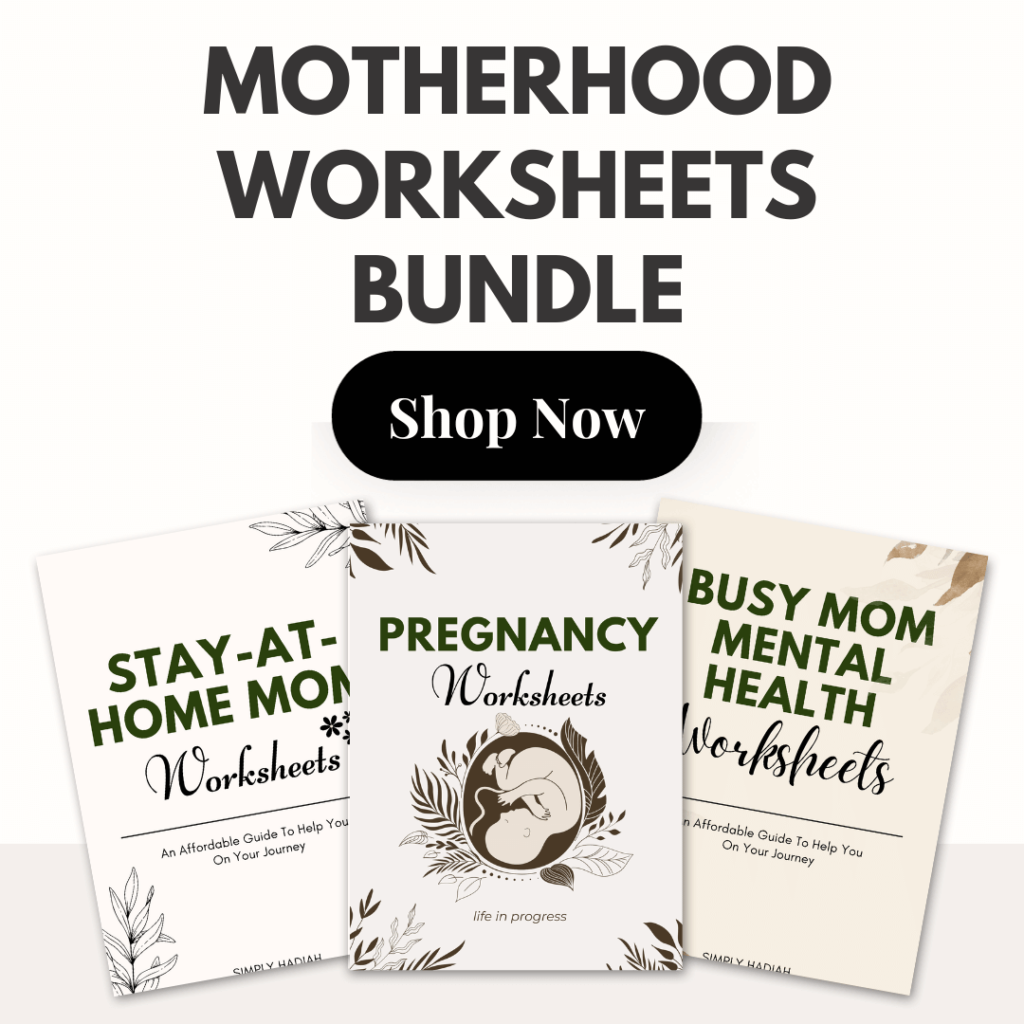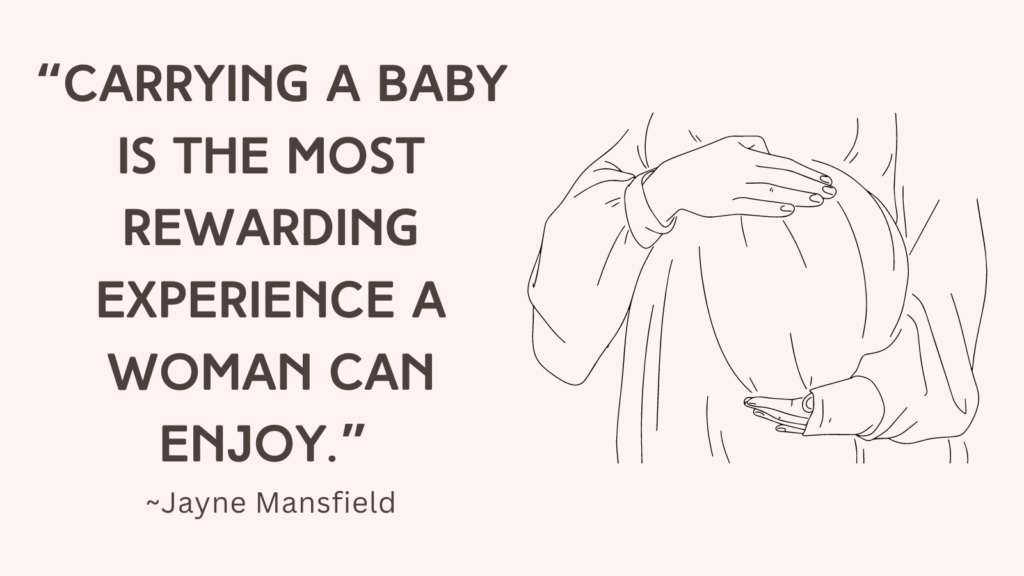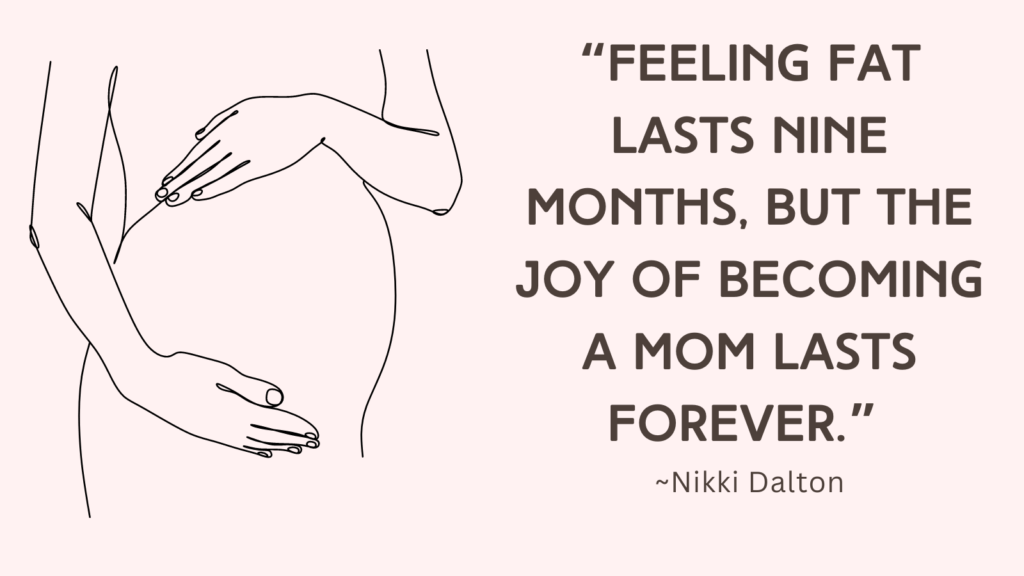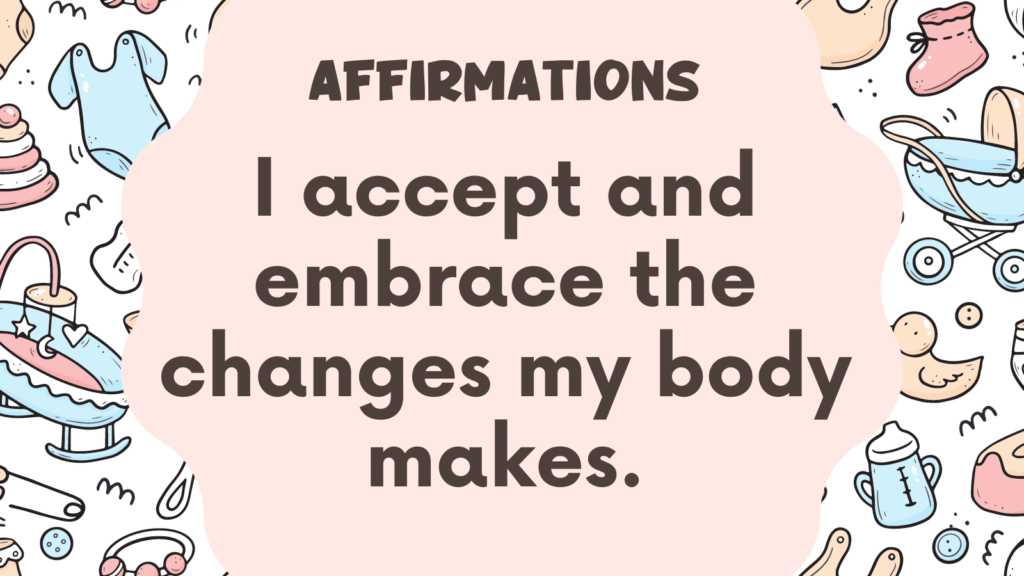This post contains pregnancy hacks that will make your pregnancy easier.
Disclosure: Some of the links below are affiliate links. This means that, at zero cost to you, I will earn an affiliate commission if you click through the link and finalize a purchase.
Pregnancy Hacks
Everyone has a totally unique pregnancy. Read through the following pregnancy hacks and use the ones you find helpful:
#1. Find Local Recommended Healthcare Providers
Search on the internet or social media for forums or online groups of parents who can recommend nearby healthcare providers, hospitals, birthing centers, and other resources you may need.
Save important numbers (e.g. doctor’s office, nurse hotline) and don’t hesitate to reach out if you have any concerns.
#2. Do Some Research On Delivery Options
Are you considering delivering in a hospital? At a birthing center? Or at home? Will you seek the help of an ob-gyn? A midwife? A doula?
See what’s available in your area and discuss those options with your partner before you decide which one is best for you.
#3. Ask Your Insurance Company About Any Pregnancy And Baby-Related Coverage Questions
Review your plan and find out what is covered, including prenatal care and appointments, inpatient services, postnatal care, and newborn care.
Related: Best 7 Pregnancy Self Care Products
#4. Plan Your Finances
Discuss with your partner your financial plans.
You may choose to meet with a financial advisor or do your research about the costs of a baby and how that will impact your finances now and in the future.
#5. Find Out The Likelihood That Your Personal Provider Will Be The One To Deliver Your Baby
Before choosing a professional to assist you, make sure you feel comfortable with them and check the likelihood that they’ll be the one to deliver your baby. Practices that are large may assign you the doctor “on call” and not your personal OB when you deliver.
#6. Schedule Your The Next Few Months’ Appointment At Once
Many offices have busy schedules and getting an appointment at a convenient time can be difficult.
At your first appointment, see if you can schedule the next months’ appointments at once.
You may also want to make your appointments at the same time (e.g. the first Tuesday of every month) so you know when to expect them.
Set reminders for your appointments on your phone or write them down on your calendar.
Related: Top 11 Tips On How To Deal With Morning Sickness At Work
#7. Decide If You Want To Keep The Sex Of The Baby A Secret
Talk to your partner and decide if you want to find out the sex of the baby in advance.
You may find it helpful to make a list of pros and cons.
Finding Out Baby Sex Pros-Cons Worksheet
#8. Remind Your Provider At Each Appointment If You Don’t Want To Know The Sex Of The Baby
If you want to keep the sex of the baby a surprise, make sure to remind your doctor and any ultrasound technicians so they don’t accidentally spill the news during your visit.
Related: Best +25 Pregnancy Journal Prompts (+FREE PDF Download)
#9. Start A Baby Name List Early On And Update It
Deciding on a baby name can be stressful, especially when you don’t have much time left.
Start an ongoing list on your phone or on paper and jot down any names that you love.
#10. Learn About Your Company’s Policies Regarding Maternity Leave And Any Postpartum Benefits
You may find it easier to ask a fellow coworker who has had a baby if they have any information or resources to help you navigate maternity leave.
See if your company offers any postpartum benefits, such as short-term disability policies, FMLA (Family and Medical Leave Act) options, etc.
#11. Review Your Medicine Cabinet And Replace The Not-Safe-For-Pregnancy Items
Some of the meds that you may be used to taking for everyday annoyances like colds and headaches may not be safe to take during pregnancy.
Replace those with safe options.
#12. Consult Your Doctor About Your Habits
Most people already know that drinking and smoking are not safe during pregnancy, but other habits may or may not be safe for you, too (e.g. certain exercises, certain foods, certain skincare and hair products).
Discuss your habits with your doctor.
Related: Best Pregnancy Resources (Information, Apps, Books, Podcasts)
#13. Keep An Ongoing List of Questions To Ask Your Doctor
You’re bound to have lots of questions throughout your pregnancy.
Keep an ongoing list of those questions and concerns in your phone or in a small notepad and ask your doctor in the next appointment.
#14. Use A Pregnancy App
Pregnancy apps can help you track and monitor your baby’s development as well as the changes you’re experiencing with your body.
The following are some free apps you may find helpful:
Pregnancy+ (iOS/Android): this app helps you track the growth of your baby compared to fruits, animals and more.
The app also offers pregnancy-planning tools, such as a calendar to track prenatal appointments, hospital bag lists, and an exportable birth plan.
Pregnancy Tracker and Baby App: WTE (iOS/Android): the app includes 3D renderings of your baby, information on its development, your own body changes, and recommended products.
It also has separate groups for users who are having their babies within the same month along with a due date calculator.
Glow Nurture Pregnancy Tracker (iOS/Android): along with fetal development images and updates on baby’s size, the app also includes miscarriage support, including trackers for unusual symptoms and emotional well-being.
The app also has additional features including product recommendations and reviews from other parents and a baby kick counter and contraction tracking.
#15. Select One Or Two Pregnancy Newsletters To Sign Up For
Pregnancy newsletters can offer great resources but don’t go overboard and fill your inbox with dozens of them.
Choose the ones you find most helpful. The following are some suggestions:
American Pregnancy Association Week-By-Week Newsletter: You will receive helpful tips, insights and recommendations for every phase of your pregnancy.
NHS Baby Newsletter: You will receive trusted advice tailored to your stage of pregnancy, or your child’s age.
Pregnancy, Birth and Baby Newsletter (Australian Government service): You will receive regular information and advice for your pregnancy or your newborn.
Today’s Parent Newsletters: Offers newsletters for when you’re trying to conceive, when you’re pregnant, when you have a baby, and when you’re a parent.
#16. Keep Plastic Bags For On-The-Go Nausea
Nausea is not just for mornings.
Pack a few plastic bags in your purse or care for when nausea hits and you don’t have easy access to a bathroom or trash can..
#17. Stretch Gently Throughout The Day
It can be difficult to stay active, especially when you have a full-time job.
Stretching every now and then can help boost your energy and make your body less achy.
Related: Best +75 Pregnancy After Loss Affirmations
#18. Switch To Grocery Delivery
Switching to grocery delivery can save you time and energy. It can also help you avoid nausea hits, if you’re feeling sensitive to smells during the first trimester.
#19. Use Elastic Hair Ties To Extend Your Waistbands
Before you switch to maternity jeans, elastic hair ties can help make your jeans last longer.
Loop a hair tie through the buttonhole, and use the rubber band to secure the button.
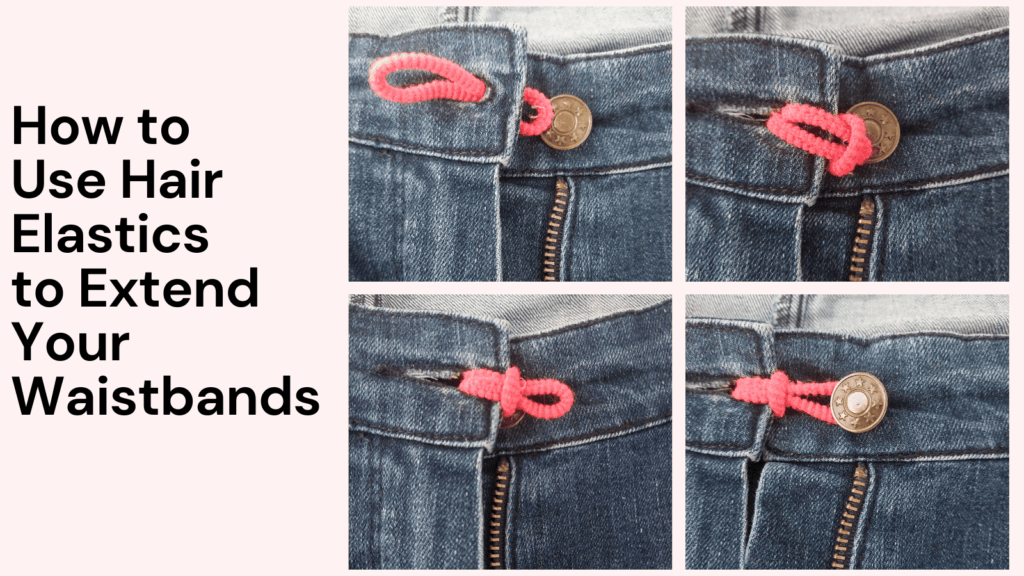
You can also use waistband pants extenders.
#20. Use Belly Bands To Keep Wearing Your Pre-Pregnancy Pants And Tops
Belly bands are stretchy fabrics that you position at your waistband to secure your unbuttoned pants and cover your belly if your shirt rides up.
#21. Use Bra Extenders
Bra extenders are extra hooks that can be easily added to your bras and are far less expensive than new bras.
These will extend the band of your bras so you can keep wearing your pre-pregnancy bras as your rib cage expands.
#22. Use A Jacket Extender To Keep Wearing Your Pre-Pregnancy Jacket
Jacket extenders can help you zip up your coat. They can also be far less expensive than buying a new jacket.
#23. Get New Shoes A Half Or One Size Larger
Your feet may grow during pregnancy due to swelling.
If your current shoes are feeling snug, consider buying a new pair a half or one size larger to keep yourself comfortable.
#24. Use Compression Socks For Swelling
It’s common to experience swelling in the feet and ankles during pregnancy.
Compression socks can help reduce swelling. They may even stop you from feeling light-headed or dizzy when you stand up. (source)
Make sure the socks are firm but not uncomfortable.
Put your socks on as soon as you wake up. If your legs, ankles, or feet are already swelling, elevate your legs for a bit before putting them on.
#25. Shop For Postpartum Items During Your Second Trimester
The first few months after childbirth, your body will likely be the same size it is in the second trimester.
Start planning ahead for your first few months with the baby.
Think about how the weather is going to be and if you’re planning to breastfeed, think about nursing-friendly clothes (e.g. nursing tank tops with strap clips).
#26. Buy Stretchy Clothes
Consider purchasing items made from stretchy material for clothes that will fit for months as your belly grows.
When you try on clothes, give them a tug to make sure that they will not become see-through when your belly grows.
#27. Switch To Wireless Bras
Wireless bras are especially good for when your breasts get swollen and sore.
Choose a supportive yet comfortable bra with stretchy cups for your growing breasts.
#28. Switch to Online Shopping
Do your shopping online to avoid uncomfortable and small changing rooms.
Use sites that offer free shipping and free returns.
#29. Protect Yourself From The Sun
The skin is more sensitive during pregnancy, which can mean it’s more likely to burn in the sun. (source)
Changing hormone levels can also make you more prone to skin pigmentation (coloration). The condition is called melasma, or what
some refer to as the “mask of pregnancy.” (source)
Find a stylish hat that you love and wear a “broad-spectrum,” (offers UVA and UVB protection) mineral-based sunscreen with an SPF of 50.
#30. Use Adhesive Bandages To Cover Your Belly Button
Your belly button may stick out at a certain point in pregnancy.
If you’re wearing formfitting clothes and would prefer not to have your belly button visible, cover it with an adhesive bandage or a nipple cover.
You might also find it helpful to cover your belly button if it’s uncomfortably rubbing against your clothes.
#31. Remove Your Rings At The First Signs Of Hand Swelling
If your hands start swelling, take off your rings before it becomes too painful to remove them.
If you don’t want to part with your ring, you may wear your ring as a necklace.
#32. Use Windex Or A Floss For Stuck Rings
If your ring gets stuck, try using soap and water or Windex to remove it.
If that doesn’t help, use a dental floss.
Slip the floss under the stuck ring with the bulk of it toward the fingertip. Then wind the floss around your finger, compressing the finger, all the way up and over the knuckle.
#33. Use Olive Oil Or Coconut Oil To Soothe Your Itchy Skin
Your skin may get tight and itchy particularly on your belly. Use olive oil or coconut oil for moisturizing relief.
You may also find pregnancy-safe body oil or butter helpful to stay moisturized.
#34. Use Cornstarch In Your Bra To Avoid Boob Sweat
As your breasts become fuller, you may experience boob sweat.
Cornstarch is absorbent and can offer relief.
There are also products available specifically to fight boob sweat.
#35. Use Long-Handled Kitchen Tongs To Pick Up Something On The Floor
As your body grows, it might become challenging to bend or squat and pick up things off the floor.
Long-handled tongs can help you pick things up.
#36. Get A Pregnancy Pillow
A pregnancy pillow can help you sleep easier at night.
Starting in the second trimester, most doctors recommend that women stop sleeping on their back because the weight of the uterus can reduce blood flow to the baby and increase risk of stillbirth. (source)
The idea sleeping position during pregnancy would be side sleeping.
A pregnancy pillow can offer support to make side sleeping more comfortable.
#37. Use Your Baby’s Sound Machine To Get Quality Sleep
White noise is a type of sound that contains all frequencies, and it can help you sleep faster and stay asleep by masking other sounds in your environment that may be keeping you from falling asleep.
If you already got a sound machine for your baby, you may use it yourself now to create a soothing atmosphere that helps you drift off faster.
If you don’t like white noise, some machines offer nature sounds, like gentle rainfall or ocean waves.
#38. Get A Pregnancy Belt
Round ligament pain (a sharp pain around the lower belly or groin) is a common, normal pregnancy symptom that usually occurs in the second trimester, as the uterus and surrounding ligaments stretch.
Rest and yoga exercises may help.
A pregnancy belt or supportive belly band can also offer relief by providing extra support for the lower back and abdomen.
#39. Use Kinesiology Tape to Relieve Pain
Kinesiology tapes are often used by athletes to relieve pain, reduce swelling and inflammation, and provide support to joints and muscles.
You can also use the tape to relieve back pain and reduce foot swelling.
Speak with a professional to make sure that you are applying the tape correctly.
#40. Reduce Swelling By Keeping Your Feet Elevated
Put your feet on pillows, an ottoman, or a stepstool to relieve swollen feet and ankles.
#41. Use A Small Pillow At Work To Relieve Back Pain
Bring a small pillow to work and place it behind your back to provide lower back support.
#42. Use A Mini Desk Fan To Cool Off At Work
If your office doesn’t have enough air-conditioning and you tend to feel hot and sweaty, use a small USB- or battery-powered fan to cool off.
#43. Sign up for Prenatal Pilates Class
Prenatal Pilates can help alleviate back pain and maintain a strong connection to the pelvic floor and deep core muscles, preparing you for birth.
Overall, Pilates during pregnancy is a safe exercise during pregnancy and afterward.
However, just like other exercises, it is recommended that Pilates be done under the guidance of a specialized Pilates instructor.
#44. Try Swimming As A Workout
According to the American College of Obstetricians and Gynecologists, swimming is one of the safest forms of exercise for pregnant women. (source)
The water will support your weight and will keep you cool while you’re being active.
#45. Make A List Of Skincare And Haircare Ingredients To Avoid
Write down a list of ingredients to stay away from and consult with your doctor if you are unsure of certain ingredients.
Keep the list in your phone so you can quickly reference it when buying new products.
You may also consider opting for natural skincare and haircare products.
Note that products labeled “natural” are not necessarily pregnancy-safe.
#46. Drink Most Of Your Water In The First Half Of The Day, To Minimize Night Wake-Ups
Because your uterus is becoming larger to accommodate your growing baby, it will push against your bladder, which causes you to pee more frequently.
It’s important to stay hydrated. You may find it helpful to drink most of your daily water intake during the first half of the day and then slowly decrease your intake in the late afternoon and evening.
#47. Use A Stepstool To Promote Good Pooping Posture
Constipation can be extra uncomfortable during pregnancy.
A high-fiber diet can help (fruits, vegetables, beans, prunes).
Placing your feet on a low stool when using the bathroom can also help things move along naturally.
#48. To Reduce Diastasis Recti Roll To Your Side When Getting Out Of Bed
When getting out of bed, instead of sitting straight up, gently roll your body to the side and use your arms to push yourself up.
This reduces pressure on your abdominal muscles and reduces diastasis recti (the separating of ab muscles).
#49. Consider Acupuncture To Relieve Pregnancy Symptoms
Acupuncture is an ancient healing method in which practitioners insert fine needles into specific parts of your body to treat health problems.
Studies show that acupuncture can help relieve:
Current information suggests that acupuncture is relatively safe for most pregnancies. You may experience mild complications (e.g. pain or swelling at the needle insertion point) but they’re not long-lasting.
Speak with your doctor before trying acupuncture to help with pregnancy symptoms or for your overall well-being.
#50. Change Positions To Relieve Lighting Crotch
Lightning crotch is a sharp, sudden pain that you may feel in your vagina, rectum, or pelvis. It’s not a sign of labor, and typically isn’t an indicator of anything serious. Pregnant women usually experience lightning crotch in the third trimester, when the baby is larger and has moved down into the pelvis. (source)
Gently changing positions can help the pain to pass.
#51. Use An Anti-Chafe Glid To Prevent Rubbing Between Your Thighs
With your body growing, you may experience uncomfortable rubbing between your thighs when wearing dresses.
An anti-chafe glide or a nontoxic deodorant can help.
#52. Download A Meditation App
Research shows that practicing mindfulness mediation is not only safe for pregnant women, but also offers a wide range of benefits for their emotional and overall wellbeing. (source)
The following are some free meditation apps that you may find helpful:
Insight Timer: Offers a number of features including guided and freeform mediations and soothing music playlists, live workshops, expert talks, and courses from its catalog of experienced teachers.
Calm: Offers a variety of mediations designed to reduce anxiety, improve sleep, boost focus and more. It also offers over 250 sleep stories, calming music, guided meditation lessons, and nature sounds.
The Mindfulness App: Offers a wide range of free and paid choices for relaxing the mind and rejuvenating the body. Get access to more than 250 guided and silent meditations.
#53. Create A Baby Registry
Allow your loved ones to show their support by setting up a registry with all the baby items you’re going to need.
Sign up for a universal registry where you can select items from multiple retailers.
Babylist: This is a universal registry that lets you add items to your wishlist from any online retailer.
Amazon baby registry: Amazon offers practically every baby brand you can think of and frequently offers deals on them. Plus, Amazon provides fast and free shipping on eligible items.
#54. Ask Your Mom Friends For Recommended Products
Your mom friends can a great source of product recommendation.
Try asking friends who lead a similar lifestyle to you to get recommendations that fit how you live and your budget.
#55. Write Nesting To Do Lists
Nesting during pregnancy refers to the overwhelming desire to get your home ready for your new baby.
You may wake up one morning in your last trimester and feel the urge to clean and organize your house.
Create to-do lists to help you tackle your house strategically.
Make sure you don’t get carried away with everything you’re getting done and decide to do some heavy lifting. Instead, write a list for your partner with heavy items to help you with.
#56. Get Door Latch Covers To Quiet Door Closing
Door latch covers are small pieces of fabric that loop over the door handles and cover the latch.
Use it for rooms where your baby will be sleeping to reduce the sound made by opening and closing doors.
#57. Minimize Creaks And Squeaks Around Your House
Consider minimizing any creaks and squeaks around the house using WD-40 or any other appropriate method.
#58. Pack Your Hospital Essentials During The Third Trimester
Packing your bag early on so you can quickly grab it when time comes and so you make sure you don’t forget any essentials.
Related: Minimalist Hospital Bag Checklist (+Hospital Bag Checklist PDF)
#59. If Your Hospital Offers Tours, Take Advantage Of It
Some hospitals offer tours to show you where you can park and what the rooms look like. This can create fewer unknowns and reduce your stress.
#60. Sign Up For Childbirth and Childcare Classes
There is a wide range of childbirth and childcare classes, both in person and online.
Decide what is best for you so you can feel prepared enough.
Find a list of childbirth classes Here.
#61. Do Your Best To Keep Moving
During your last trimester, you may feel weighed down and tired.
Do your best to keep moving. Schedule five-minute walks around the block throughout the day.
Squats are also highly recommended because they can help strengthen your pelvic floor muscles, in the case of an uncomplicated pregnancy with physician clearance. (source)
#62. Use A Birthing Ball For Gentle Exercise
A birthing ball or a large inflated exercise ball is great for exercising while pregnant or to prepare for labor.
It helps to strengthen core and back muscles.
It can also relieve pregnancy aches.
When you’re in labor, using the ball can help open your pelvic and hips.
#63. Eat Dates To Promote Natural Labor
Dates are a healthy way to satiate your sugar cravings and cut back on artificial or added sugar.
Research also show that that the consumption of date fruit in the last 4 weeks before labor significantly reduced the need for induction and augmentation of labor. (source)
#64. Make and Freeze Lactation Cookies
If you plan on breastfeeding, there are certain ingredients that are shown to boost milk production, like oatmeal, brewer’s yeast, flax seeds, and fenugreek. (source)
You can look up a recipe online that includes those ingredients or buy ready-made ones.
#65. Sign Up For Auto Delivery Of Baby Essentials
There are lots of items that you’ll need frequently once the baby is here, like diapers and wipes.
Signing up for auto delivery from an online retailer before the baby arrives can make things easier for you.
#66. Get Nursing Pads Or Cotton Rounds To Prevent Milk Stains
It is common for your nipples to leak during the end of pregnancy and while breastfeeding.
Get disposable or washable nursing pads or use cotton rounds to prevent the leaking before it gets to your shirt.
#67. Get Overnight Pads Or Adult Diapers For Your Postpartum
Heavy bleeding is normal after pregnancy and can last between four to six weeks after giving birth.
You cannot use tampons until you’ve had your 6-week postnatal check due to risk of infection. (source)
#68. Practice Labor Positions At Home
Research and practice a handful of labor positions to help with the pain of labor and encourage the baby to descend.
Don’t wait until you’re actually in labor to try them.
You can try them with your partner so they know how to best assist you.
#69. Practice Labor Breathing
Here are some basic breathing techniques that you can try:
- Slow breathing: Take a slow, deep breath in through your nose and exhale slowly through your mouth. Focus on your breath and try to relax your body with each exhale.
- Counted breathing: Take a deep breath in through your nose and hold it for a few seconds. Exhale slowly through your mouth while counting to 5. Repeat the process several times.
- Pursed lip breathing: Take a deep breath in through your nose and exhale through your mouth with pursed lips. This technique can help you breathe more slowly and deeply.
- Rapid-paced breathing: Take a series of short, quick breaths in and out through your mouth. This technique can help you cope with contractions and manage pain.
Don’t hesitate to ask your healthcare provider for guidance on breathing techniques that might work best for you.
#70. Download A Contraction Tracking App
Once you begin to have contractions, you’ll need to start timing how long each contraction lasts and how long it is between contractions. The following app can help:
Contraction Timer & Counter 9m
#71. Hire a Doula
Doulas are trained professionals who provide emotional, physical, and informational support to birthing people and their families before, during, and after childbirth.
They can also offer assistance with postpartum care, breastfeeding, and newborn care.
Doulas work alongside medical professionals like doctors and nurses to help ensure that the birth experience is as positive and empowering as possible for everyone involved. Use the following directory to find a doula: https://www.dona.org/what-is-a-doula/find-a-doula/
Conclusion
Every woman experiences pregnancy in a different way.
While pregnancy is a beautiful experience, you may find parts of it uncomfortable be it the physical discomfort, the sleepless nights, or the feelings of anxiety.
Using pregnancy hacks can make all three trimesters easier and less uncomfortable.
References
- Portions of this article were adapted from the book Pregnancy Hacks, © 2020 by Amanda Shapin Michelson. All rights reserved.
- Department of Health & Human Services, “Pregnancy – morning sickness,” Better Health Channel, 24-May-2001. [Online]. Available: https://www.betterhealth.vic.gov.au/health/healthyliving/pregnancy-morning-sickness
- NHS choices. [Online]. Available: https://www.nhs.uk/pregnancy/related-conditions/common-symptoms/swollen-ankles-feet-and-fingers
- M. Bender, L. Rapaport, B. Upham, M. D. Landau, C. Alkon, and S. Lindberg, “10 ways pregnancy changes your skin,” EverydayHealth.com. [Online]. Available: https://www.everydayhealth.com/pregnancy/10-ways-pregnancy-changes-your-skin/
- “How pilates affects your pregnancy,” WebMD. [Online]. Available: https://www.webmd.com/fitness-exercise/what-to-know-pilates-during-pregnancy.
- A. Marcin, “Acupuncture during pregnancy: Safety, benefits, and risks,” Healthline, 24-Aug-2021. [Online]. Available: https://www.healthline.com/health/pregnancy/acupuncture-during-pregnancy.
- “Lightning crotch: Causes, remedies, and how it feels,” Medical News Today. [Online]. Available: https://www.medicalnewstoday.com/articles/322088.
